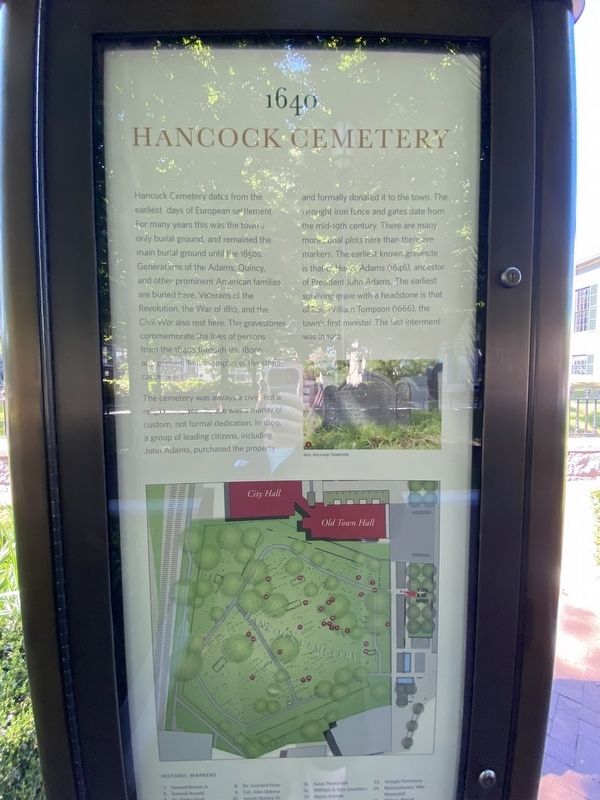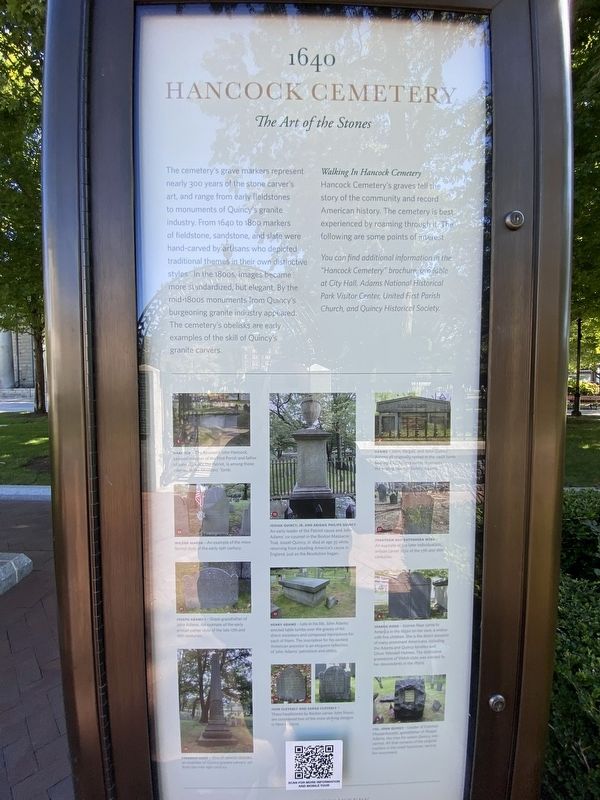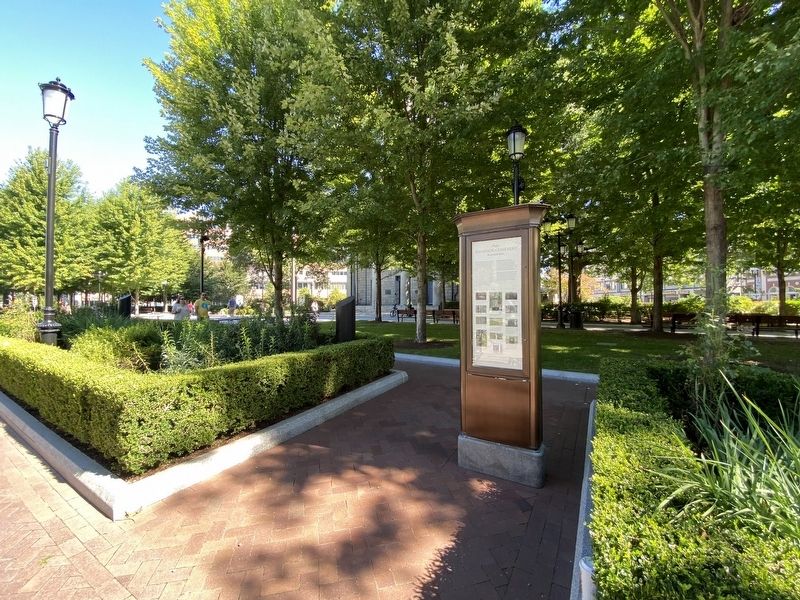Quincy in Norfolk County, Massachusetts — The American Northeast (New England)
Hancock Cemetery
1640
Hancock Cemetery dates from the earliest days of European settlement. For many years this was the town's only burial ground, and remained the main burial ground until the 1850s. Generations of the Adams, Quincy, and other prominent American families are buried here. Veterans of the Revolution, the War of 1812 and the Civil War also rest here. The gravestones commemorate the lives of persons from the 1640s through the 1800s, and present fine examples of the stone carver's art.
The cemetery was always a civic, not a religious, space. It's use was a matter of custom, not formal dedication. In 1809, a group of leading citizens, including , John Adams, purchased the property and formally donated it to the town. The wrought iron fence and gates date from the mid-19th century. There are many more burial plots here than there are markers. The earliest known gravesite is that of Henry Adams (1646), ancestor of President John Adams. The earliest surviving grave with a headstone is that of Ray William Tompson (1666), the town's first minister. The last interment was in 1972.
( back )
The cemetery's grave markers represent nearly 300 years of the stone carver's art, and range from early fieldstones to monuments of Quincy's granite industry. From 1640 to 1800 markers of fieldstone, sandstone, and slate were hand-carved by artisans who depicted traditional themes in their own distinctive styles. In the 1800s, images became more standardized, but elegant. By the mid-1800s monuments from Quincy's burgeoning granite industry appeared. The cemetery's obelisks are early examples of the skill of Quincy's granite carvers.
Walking In Hancock Cemetery
Hancock Cemetery's graves tell the story of the community and record American history. The cemetery is best experienced by roaming through it. The following are some points of interest.
You can find additional information in the "Hancock Cemetery" brochure available at City Hall, Adams National Historical Park Visitor Center, United First Parish Church, and Quincy Historical Society.
( photo captions )
Hancock - Reverend John Hancock beloved minister of the First Parish and father of John Hancock the Patriot, is among those interred in the Ministers' Tomb.
Wilson Marsh - An example of the more formal style on the early 19th century.
Joseph Adams - Great grandfather of John Adams. An example of the early artisan carver styles of the late 17th and 18th centuries.
Freeman Hunt - One of several obelisks. An example of Quincy granite carvers' art from the mid-19th century.
Josiah Quincy, Jr. and Abigail Philips Quincy - An early leader of the Patriot cause and John Adams' co-counsel in the Boston Massacre Trial. Josiah Quincy, Jr. died at age 35 while returning from pleading America's cause in England, just as the Revolution began.
Henry Adams - Late in his life, John Adams erected table tombs over the graves of his direct ancestors and composed inscriptions for each of them. The inscription for his earliest American ancestor is an eloquent reflection of John Adams patriotism and ethics.
John Cleverly and Sarah Cleverly - These headstones by Boston carver John Noyes are considered two of the most striking designs In New England.
Adams - John, Abigail, and John Quincy Adams all originally rested in the vault tomb bearing J.Q. Adams name. It remains the resting place of Nabby Adams.
Jonathan and Bathsheba Webb - An example of the later individualistic, artisan carver style of the 17th and 18th centuries.
Joanna Hoar - Joanna Hoar came to America in the 1650s on her own, a widow with five children. She is the direct ancestor of many prominent Americans, including the Adams and Quincy families and Oliver Wendell Holmes. The distinctive gravestone of Welsh slate was erected by her descendants in the 1890s.
Col. John Quincy - Leader of Colonial Massachusetts, grandfather of Abigail Adams, the man for whom Quincy was named. All that remains of the original markers in the small footstone next to the monument.
Topics. This historical marker is listed in this topic list: Cemeteries & Burial Sites.
Location. 42° 15.049′ N, 71° 0.203′ W. Marker is in Quincy, Massachusetts, in Norfolk County. Marker is at the intersection of Hancock Street and Coddington Street, on the right when traveling south on Hancock Street. Touch for map. Marker is at or near this postal address: 1305 Hancock Street, Quincy MA 02169, United States of America. Touch for directions.
Other nearby markers. At least 8 other markers are within walking distance of this marker. A different marker also named Hancock Cemetery (here, next to this marker); The Men of Quincy, Mass. (a few steps from this marker); Colonel John Quincy (a few steps from this marker); United First Parish Church (within shouting distance of this marker); James R. McIntyre, A.B. M.A. J.D. (within shouting distance of this marker); Church of the Presidents (within shouting distance of this marker); Quincy Town Hall (Old City Hall) (within shouting distance of this marker); Henry Adams (within shouting distance of this marker). Touch for a list and map of all markers in Quincy.
Also see . . . Hancock Cemetery (Wikipedia). (Submitted on November 2, 2023, by Michael Herrick of Southbury, Connecticut.)
Credits. This page was last revised on November 2, 2023. It was originally submitted on October 15, 2023, by Darren Jefferson Clay of Duluth, Georgia. This page has been viewed 66 times since then and 22 times this year. Photos: 1, 2, 3. submitted on October 27, 2023, by Darren Jefferson Clay of Duluth, Georgia. • Michael Herrick was the editor who published this page.


